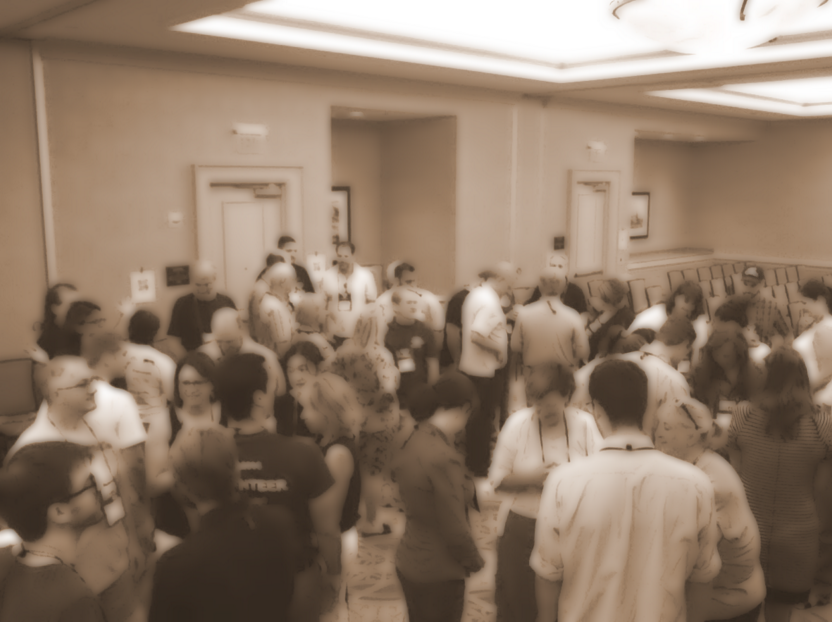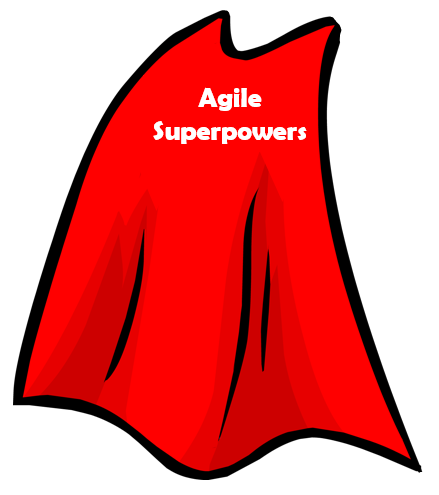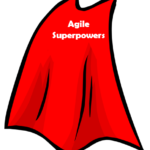Agile Superpowers are feeling skills or attitudes. How can you up your game and tap into your inner wisdom to help your teams and organization? They can be looked at as a space to ‘come from’ when working with others in a team, as a leader, as a coach, or in any capacity that requires you to engage with others. The idea of Agile Superpowers is based on metskills (more on that later).
The challenge in writing or talking about Agile Superpowers, is how to convey a feeling or attitude in words. There is an essence that we don’t want to lose when talking about Agile Superpowers, but in trying to define them we risk losing that essence. One example of an Agile Superpower is curiosity. Curiosity not about being a “questioner”, but to have curiosity in your bones! I mean REALLY REALLY REALLY curious! The kind of curious where judgement and ego fade away!
I often think of Agile Superpowers as flavors of tea. You can use them to “flavor” the group, team, or space you are in. Imagine curiosity tea. The curiosity spreads through the water leaving a taste of curiosity in each sip.
A Story of Superpowers
Consider this situation. I’m coaching a team of 8 people. I’ve been told, before meeting with the team, that “one member of the team is not pulling his weight.” He is not finishing the work he is committing to and is not helping anyone else.” I meet with the team to work with them on their top issues. One way I use Agile Superpowers is to choose one to focus on in a particular engagement (meeting, coaching session, etc.). In the situation I describe here, I choose curiosity.

My intent is to bring my curiosity to the coaching session with the team. Think about a person who is always bringing humor to situations to lighten the mood – I want to bring curiosity in that way. I want to bring curiosity as an attitude – a contagious attitude. I may ask powerful questions, I may listen at level four, I may hold silence, or I may facilitate a retrospective on the the last iteration the team just completed. In all of these approaches, I want to hold curiosity. I want to sink into curiosity… to soak in it!
As I started working with the team, I noticed that a few people appeared to be quite frustrated (based on statements they made and observations of the dynamics). They pinned this frustration on not completing the work they were committing to get done. They all agreed it was within reach (even the person who I was told “was not pulling his weight”). I considered bring this apparent contradiction up, but I felt this was not the right move for the team. The energy started to get more intense (my word for what I was perceiving) in the room as people had more time to sit with this idea. Some of the discussion on the topic started to focus on people and individuals. Sometimes bringing curiosity at this level works and sometimes you might want to work with it more directly. You might ask questions from an attitude of curiosity or you might decide you need to work through an exercise with them on that Agile Superpower.
Experiencing Curiosity
This is one of those situations where you, as a coach, make a choice on an approach, at least to try. I already decided not to point out an apparent contradiction and decided to stick to that track — I fully believed in this team and their relationship, even though things were heating up and they had some issues in the past with toxins. The decision to trust that they are intelligent and creative is not always as simple as just saying it of course! I asked if they were willing to try something and they all said they would – I guess there was enough trust. I had them each write down 1 or 2 reasons that work was not getting done. After a few minutes, when they had that done, I taped a square on the floor with some green painters tape, that was large enough to stand inside. I wrote ‘Curiosity’ on a sheet of paper and placed it in the square. I walked to the back of the room and sat down. I asked who would be willing to read one of the reasons work was not getting done to the rest of the team – and added a twist. I asked the first person who volunteered to stand outside the curiosity square and read the statement they wrote to themselves. Then to step into the curiosity square, when they were ready and read it in a way that came from pure curiosity.
A curious thing happened. There were some long pauses as people took time to really think about how to read their statements in a way that was not about blame or judgement. The end result was hearing people who were upset with the person who was “not getting work done” asking deep questions about the process and about what was really happening. One person asked something like, “I’m curious as to how I can be helpful when I’m frustrated?” The speakers continued to bring up many different levels of ideas and questions. In some cases people would start with questions that sounded more like blame, but would adjust on the spot and restate the question without (or with less) judgement. You could see the energy shift in the room and become softer. The person who was labeled as having issues getting work done noted that they “were simply wondering what to do?” I asked if they could say more and after a long pause they started to explain that they had some serious issues happening at home. The room shifted at that point. This was a person who had seven teammates who just assumed this guy did not care. They could now see how sad this guy was both about letting the team down, but also about the serious issue that was happening to him.
This situation is a fictional story cobbled together from a number of real events to protect confidentiality. You may have experienced something like it yourself. Was everything now all magical and taken care of? Was the work suddenly all caught up and done? Was this guy excused from having to get his work down? Of course, the answer is NO!
What did changed however was they, as a team, were able to work together at an entirely new level — they could feel and be as a team in a new way. This experience allowed them to see a new level of information about themselves and the team. There were other insights and they worked to come up with an approach to get back on track.
A Brief History Of Metaskills
Agile Superpowers are based on metaskills. Amy Mindell coined the term metaskills in 1994. She was looking at metaskills as a way to understand why some therapists were more effective than others when both had the exact same training. What were they doing differently? Through research and observation, she arrived at the idea that “Metaskills are the feeling qualities, or attitudes that bring learned skills to life and make them useful.” Her book, Metaskills : the spiritual art of therapy elaborates on this concept.
While introducing the book, Amy points out how we need to take our “feeling attitudes” and “raise these essential, underlying feelings … to ‘skills’ that must and can be studied and cultivated.” We often ignore these feelings and attitudes or are not even aware of them. Amy’s idea, that we can actually focus on, improve, and grow from these attitudes is very important to our ability to succeed into today’s business (and agile) world! We need to tap into all that we can to be successful.
Kiyoshi Hamano, in a discussion about metaskills and Amy’s book, notes “… the essence of psychotherapy exists beyond the differences among schools.” When I first read this I thought about agile and agility — and the many battles between the ‘agile camps.’ When battle lines are drawn between agile camps, if we look to the essence, we can see the answer and often the silliness of the battle related questions.
Kiyoshi goes on to say “There exists wisdom, which is independent of the knowledge and techniques that each school has cultivated, and which is needed in whatever schools we may choose.” [Source: Kiyoshi Hamano; Japanese Journal of Clinical Psychology,” Vol. 4, No.1 January, 2004, pp.145-148, published by Kongo Shuppan in Tokyo; Translated by Ms Kazuko Sato. ].
What will it take to look beyond the ‘agile camps’ to the wisdom at the heart of them all?
Metaskills are infinite. Here are just a few of them… courage, heart, curiosity, respect, commitment, compassion, playfulness, deep democracy, service, curious silence, and many more. Think of your own. Amplify ones you have used. For example, you can focus on a challenge by being curious or you focus on being fascinated. How would bringing fascination help you see a challenge differently?
Metaskills to Agile Superpowers
I first learned about metaskills from The Center for Right Relationships (CRR). One of CRR’s primary focuses is to train coaches. They developed an experiential metaskills exercise that allows people to truly stand-in and experience a metaskill. They use a number of metaskills

as a core part of their coaching framework as well. Through the learning process with CRR, I met Stephen Starkey (I lack the space here to do him justice — he is amazing) and we came up with the Agile Superpowers concept as a way too bring these ideas to the agile world. We have facilitated and coached people through the Agile Superpowers exercise internally at clients offices and at various conferences including the Scrum Gathering Vegas (2013), Agile2014, and (coming soon) Humanizing Work (November 2014), as well as other smaller events.
Applying these ideas to issues in the agile world makes a ton of sense. We have more and more people who are looking beyond only process and behavior to shine a light instead (or as well as) on culture and how they need to be to contribute more effectively. I have been moved by the amazing containers we have created with attendees — and the awesome trust and energy people bring to the Agile Superpowers sessions we have facilitated. It is always a humbling experience! Of course these sessions are much more like coaching sessions than ‘presentations.’ We have no slides and it is experiential with people moving around and interacting with the Agile Superpowers, with each other, and with the system.
I also find it interesting to note many of the metaskills that we initially focused on aligned directly with the Scrum values of focus, courage, openness, commitment, and respect. So for anyone who wants a very direct connection to the agile world and to Scrum, there you have it. By focusing on these values or agile superpowers, and learning from them, we can go beyond courage simply being “a word.” We can start to benefit from understanding the essence of courage.
A shot from the session at Agile2014 in Orlando
RT @heidihelfand: Agile superpowers w @jcalabrese reflect with movement #geography #agile2014 pic.twitter.com/jonmoc2Jar #orsc @stephencstarkey
— Jake Calabrese (@jcalabrese) August 5, 2014
The abstract from our session at Agile2014, provides a sense of what we were aiming for:
Get in Tune with Your Agile SuperPowers!
Are you facing a challenge or problem with another person, a team, or even with yourself? Do you have something blocking you from moving forward and you can’t quite figure it out? Bring some challenges and join us for Agile Superpowers. Learn a simple, yet profound framework you can use to get amazing insights to the challenges you face. You will have a chance to choose a number of superpowers to apply to your challenge(s) from the 7 we introduce you to. Learn what an agile value feels like with Superpowers including deep democracy, courage, curiosity, respect, commitment, playfulness, and collaboration – allowing you to access wisdom not normally available to solve problems!
Agile Superpowers are about attitude and feeling – well beyond just “be curious”. Feeling an agile value is like having a Superpower! There is an essence to it and everyone has a unique feeling that each person just has to experience themselves! Have you had a ‘moment of ah’ or watched people have a moment like that? That is the feeling – the moment where you get goose bumps! Join us as we tap into what it takes for us to be human, be amazing, and be agile!
Agile Superpowers can let you enhance how you practice agile, they can help you understand what is happening at a new level and offer you insights into challenges that you had not previously seen.
Moving Forward
I’ve included a few ideas here of how to use Agile Superpowers, from working with them individually, to using them in group exercises. There are many ways to tap into them and really get a “feel” for them that go beyond an article. Pick one Agile Superpower and work with it, write it on a sticky and keep it present with you at all times. Pick one that is related to something you are working on to improve yourself and check-in with it throughout the day. Ask yourself what’s next with the Superpower to go deeper into the attitude of courage, service, respect, or whichever one you choose. This is a start. Remember, you can always choose another one that serves you better at a given moment.
If you are interested in learning about becoming a coach who can coach groups through these types of sessions, check out CRR or let me know if you have questions. If you are interested in a workshop like this for your organization, I’d be glad to discussion the details and the options.











I love the exploration of curiosity from a group perspective, and I particularly like the exercise you mentioned. How many groups could reach another level of collaboration if they were fully committed to each other and authentic curiosity?
I would hope most of them! It’s certainly one of the things that keeps me motivated and passionate about this work!